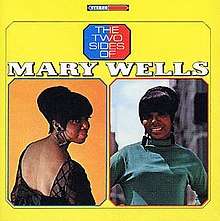The Two Sides of Mary Wells
The Two Sides of Mary Wells is the seventh studio album by soul singer Mary Wells, released on the Atco label in 1966. By now, Wells' career had drastically changed from just six years before when the then-teenage Wells first recorded songs for Motown. After being promised a movie deal with 20th Century Fox, Wells had left Motown for the label in 1965 only to find herself struggling to get radio airplay. Rumors were that Motown staff, particularly Berry Gordy, told radio deejays not to play Wells' music on the radio leading to a blacklisting of Wells' music. This album mixed traditional pop with more earthier and uptown soul songs. Wells released a modest hit with the Motown-esque "Dear Lover", which hit the top ten of the R&B chart.
| The Two Sides of Mary Wells | ||||
|---|---|---|---|---|
 | ||||
| Studio album by | ||||
| Released | 1966 | |||
| Recorded | 1966 | |||
| Genre | Soul, R&B, Pop | |||
| Label | Atco | |||
| Producer | Carl Davis | |||
| Mary Wells chronology | ||||
| ||||
| Singles from The Two Sides of Mary Wells | ||||
| ||||
Track listing
Side one
- "Satisfaction" (Mick Jagger, Keith Richards)
- "Love Makes the World Go Round" (Deon Jackson)
- "In the Midnight Hour" (Steve Cropper, Wilson Pickett)
- "My World Is Empty Without You" (Holland-Dozier-Holland)
- "Good Lovin'" (Arthur Resnick, Rudy Clark)
- "Dear Lover" (Carl Davis, Gerald Sims)
Side two
- "Where Am I Going" (Cy Coleman, Dorothy Fields)
- "Shangri-La" (Carl Sigman, Matty Malneck, Robert Maxwell)
- "On a Clear Day (You Can See Forever)" (Alan Jay Lerner, Burton Lane)
- "The Shadow of Your Smile" (Johnny Mandel, Paul Francis Webster)
- "The Boy from Ipanema" (Antônio Carlos Jobim, Norman Gimbel, Vinicius de Moraes)
- "Sunrise, Sunset" (Jerry Bock, Sheldon Harnick)
Personnel
- Bob Kidder - engineer
- Sonny Sanders - arranger on Side one
- Joe Mazzu - arranger on Side two
- Gerald Sims - conductor
gollark: It can't do arbitrary things really fast because not every problem can be converted into quantum logic gates or whatever it operates on.
gollark: As I said, quantum computing makes SOME operations faster, not all.
gollark: https://en.m.wikipedia.org/wiki/Rapid_single_flux_quantum
gollark: Apparently you can also do really fast logic with superconductors.
gollark: Also, you need ridiculous cooling as things stand.
This article is issued from Wikipedia. The text is licensed under Creative Commons - Attribution - Sharealike. Additional terms may apply for the media files.